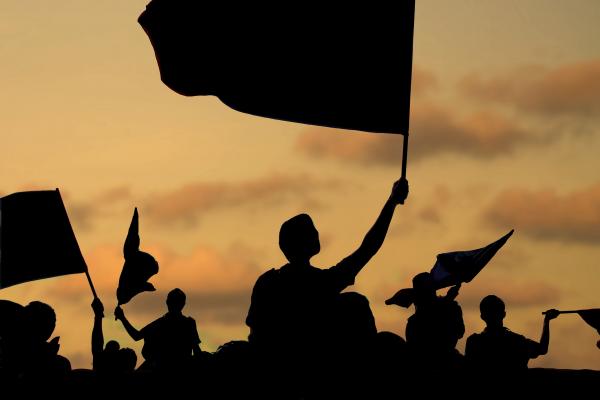What follows is the text of a talk delivered at the Sojourners Summit for Change earlier this year. This transcript has been lightly edited for online.
Three years ago, I was a U.S. State Department officer deployed to Turkey to work with the Syrian opposition. It was an amazing opportunity to support Syrian activists and civic leaders waging an improbable — yet remarkable — popular struggle, against a criminal regime that responded to peaceful protests with bullets and torture. For [the previous] eight months since the start of the revolution in March 2011, Syrian activists — Sunni, Christian, Kurdish, Druze, and Alawite — had used demonstrations, sit-ins, resistance music, colorful graffiti, online satire, and dozens of other nonviolent tactics to challenge the Assad regime. My task, along with that of my U.S. government and international colleagues, was to aid their efforts.
A year earlier, I co-wrote and published a book with Erica Chenoweth, called Why Civil Resistance Works: The Strategic Logic of Nonviolent Conflict. In it, we tested the conventional wisdom that only violence works against formidable foes like dictatorships and foreign military occupations. In studying 323 violent and nonviolent campaigns from 1900-2006, Erica and I found that nonviolent civil resistance was twice as successful as armed struggle — even against militarily superior opponents willing to use violence. We also found that nonviolent struggle helps consolidate democracy and civil peace.
These findings were put to the test in Syria. It isn’t surprising that Syrians took up arms against the regime — even as an advocate of nonviolent resistance, I tried to put myself in their shoes and imagine seeing my mother raped, my brother starved to death, and my religion ridiculed.
Tragically, [their] armed struggle played into the Assad regime’s hands. The levels of death, destruction, and displacement skyrocketed once violence was fought with violence. And extremist elements like ISIS exploited the chaos to establish a foothold.
Syrian nonviolent resistance needed more time. The average nonviolent campaign takes three years to run its course. The average armed campaign, on the other hand, takes nine years. As part of the international effort I know that we had failed. We failed collectively to help Syrians plan for a long struggle and remain resilient in the face of regime violence. We failed to provide timely and adequate support for the nonviolent resistors.
This greatly saddens me.
Now, outside of the government — at USIP and the Atlantic Council — I am dedicated to working with scholars, activists, policymakers, and members of international civil society, including faith communities, to determine how we on the outside can most effectively support nonviolent struggles for freedom and dignity. This topic merits a global conversation.
Today, Syrians are fighting multiple fronts, with the regime on one side and ISIS on another. As I wrote recently in Sojourners, Syrian women, youth, religious leaders, and other courageous activists are fighting ISIS extremism with bold and creative forms of civil disobedience and noncooperation in places like Raqqa, Idlib, and Aleppo. We should assist them by amplifying their efforts in the media, connecting them to resources, and helping bring together the quiet peacemakers from across conflict lines — notably women and religious leaders.
Hope for ending Syria’s civil war and undermining violent extremism lies in the nonviolent change agents who continue to struggle against all odds. We have a responsibility to assist them and others around the world fighting injustice and oppression with nonviolent weapons. That is putting faith in action.
Got something to say about what you're reading? We value your feedback!

